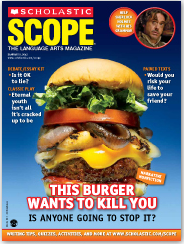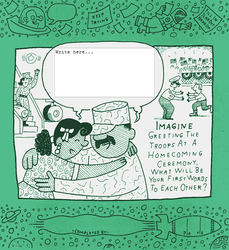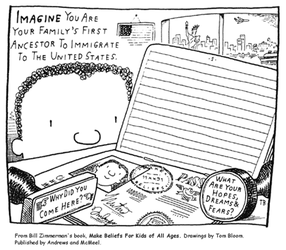 "Lifeless Face #045" by nottsexminer Do you see a face? Look again at the picture on the left. Look very closely. Now do you see a face? Recently, while perusing the gift shop in my local art museum, I discovered a create collection of photography in a book called Found Faces. Immediately, I thought "This is the result of very careful noticings and creativity! This is what I want my students to do!" Of course, the book came with a $15 price tag, which I did not have in my budget that day, so I was more than a little disappointed that I'd have to go home empty handed. My next thought (which quickly followed by my initial excitement and the subsequent sadness due to lack of funds) was to purchase the book used on Amazon. (The current price starts at only $4.86 as I'm posting this.) I was really happy to find out it was cheaper online, but my happiness did not stop there... A quick Google search revealed that there is an entire collection of these "found faces" on Flickr containing literally thousands of images similar to the photo above. Now, before you go copying photos and pasting them into Power Point presentations--or photocopying them by the thousands--do be aware that each photo in the collection has its own license terms; some have "all rights reserved," while others have only ask that you give credit to the photographer or that you do not use the photo for commercial purposes. Before you "borrow" a photograph, be familiar with its license terms and know what those terms mean. So, how can "found faces" be used in the classroom? First, I love the idea that these photos are great examples of finding the extraordinary in ordinary places, and of really approaching the everyday with a careful, watchful eye. How many times a day do we walk past a hidden face without ever seeing it? It would be a great exercise in observation to have students locate their own found faces in their schools, homes, or communities. Additionally, I see huge potential in terms of narrative writing and descriptive writing in response to these faces. I think students would enjoy viewing some of these faces and writing their background stories. This would also be a great anchor activity, or a springboard for even richer narrative and descriptive writing experiences.
0 Comments
 For this upcoming school year, I intend to make the jump from using Microsoft Word to using Google Docs. Why? Because students can start their work at school and finish at home (or vice versa). Because I don't have to worry about compatibility issues with students owning different versions of software. Because it saves automatically, so students can't blame the computers for losing their work. Because it's free, and I hope students will continue to use it long after my class. And because it's paperless, so I don't have to worry about low toner, paper jams, or any other of the countless problems that become part of my computer lab existence. I'm preparing a handout for my students to keep in their writing binders, showing them exactly what expect when it comes to formatting their papers (header, footer, margins, etc.) Why? Because if they have a tool to help them through the technical aspects, then I can focus on helping them with their writing. Please feel free to download/print/share the document below. A screencast will be coming soon...  SMORE is a new online program that allows you to design dynamic online newsletters for free. (ah, free! one of my favorite words, especially when it comes to education!) Right now, you have to request membership and wait to be approved before you can use Smore, but it is well worth the wait! Although Smore bills itself as a tool for creating flyers, it could be used to create any sort of web document; this would be an excellent site for creating a classroom webpage or a class/school newsletter. The themes are beautiful and simple, giving the pages a clean and modern look. Editing content is as easy as using Power Point, so even the web novice would be able to build online documents with ease. More experienced with building web pages? Try spicing up your newsletter by embedding pictures, links, or videos. Another great feature is that viewers can leave comments on the newsletter through Facebook, creating real-time feedback from viewers. NOTE: I'm currently using Smore to build the newsletter for the members of my local chapter of the National Writing Project. You can view my document HERE. A Cupcake Story from Smore on Vimeo.  MakeBeliefComix is a great website for creating comics and discovering writing prompts. This site offers tons of free black-and-white printables that can be photocopied and colored (using markers and crayons saves printer ink!). You can also generate your own original comic strips by choosing from their existing selection of characters, objects and speech bubbles. Another great feature are the Digital Writeables, which allow visitors to complete a comic by typing in their text and printing. One wonderful addition that sets this website apart from others is that it features a section for students with special needs, explaining how this site can be used to help all learners express their thoughts. There is also another great section for educators that gives tips on how to use comics in the classroom.  By visiting Scholastic Scope online, viewers have access to tons of free resources, including PDF files of stories and readers' theater pieces, vocabulary and grammar worksheets, ACT-style quizzes, essay writing prompts, and much much more! I'm truly amazed that there is no log-in required to view these materials. There is even information regarding how the materials align with the Common Core State Standards. According to the website, these materials will be password-protected in the future, so visit their website and save these files while it's free! I plan on using many of the resources (my school has a subscription, so I will be able to access information even after it is password-protected); I'm particularly interested in the readers' theater pieces because they are a great way to expand students' background knowledge regarding literary masterpieces.  Whether you plan to participate in National Novel Writing Month or not, this website offers some wonderful free resources that can be used all year: http://ywp.nanowrimo.org/node/ After all, why stop writing at the end of November? Print off the free PDF Writer's workbooks (available in elementary, middle school and high school levels) and conduct mini-lessons on a variety of literary elements, including the "plot roller coaster," character development, conflict, setting, mood, dialogue, and using sensory details. These workbooks are incredibly versatile, and would work well with literature circles, classroom novel studies, or student writing assignments. NaNoWriMo also includes exercises for work shopping student writing--peer review and self-review--as well as grammar checklists, and guidelines for writing a letter to an editor. Another feature that I like about the writing workbooks is that they strongly link the acts of reading and writing, asking students to reflect on positive reading experiences that they have had in order to inspire their own writing.  NaNoWriMo's plot roller coaster NaNoWriMo even offers "pep talks" from professional young adult literature authors to help keep your students on track and highly motivated. This year, I'm particularly looking forward to the pep talk given by Gayle Foreman; I just recently finished reading If I Stay, and I loved every minute of it! So, what are you waiting for? Start that novel! (Or, at the very least, beef up your writing curriculum with some top-notch resources.)  This Writing Prompts website run by teacher Luke Neff has tons of writing prompts that are great for visual learners. Each picture comes with a specific writing prompt (such as the one to the left) or a non-specific prompt (tell the story in this picture). Most of them are geared toward creative writing, descriptive writing, or narrative writing. These would make excellent prompts for writing journals, bellringer activities, or online portfolio prompts. To date, there are 258 writing prompts (plenty to stock any writing teacher for the year) and they are high-quality photos, on par with many for-purchase writing prompt books and flashcards. Click on some of the sample pictures below to enlarge the image.  Laurie Halse Anderson has published numerous writing prompts, as well as tips about the writing process, on her blog--Mad Woman in the Forest--where she challenges individual to Write Fifteen Minutes a Day for a full month. Anderson tackles topics, such as writer's block, overcoming distractions, and making time to write. Other writing prompts are more traditional, such as character or setting sketches. It's definitely the prompts about being a writer and engaging in the writing process that I was the most impressed with. As teachers, I think we tend to focus on the process of writing without ever addressing the difficulty of writing and how to overcome potential obstacles. Students begin to view as an innate skill that they are either born with, or are not; and they believe that good writers never deal with "issues." Anderson, as a very successful author of young adult literature, does a great job of "naming the beast," so to speak, and getting writers to confront the difficulties associated with writing.  Recently, a former student of mine sent me a link to a hilarious post on the blog Hyperbole and a Half, where the author talks about the irritation grammar sticklers feel when they see the phrase "a lot" incorrectly written as one word: "alot." In order to cope with other people's grammar, the blogger has created a fictional creature called the alot (see left--yup, that's an alot). Anyway, this is a fun way to teach your students about the difference between alot (wrong) and a lot (right). Below, I'm attaching files. One file is the blog post with the "alot of beer cans" removed for school-appropriateness reasons. The second file is a linemaster of the alot so your students can design their own creatures. I'm having students make alots for homework passes, and then I'm going to display them on my classroom bulletin board. (I'll be sure to post pictures asap.) UPDATE: Alots created by my students can be viewed HERE. Note: According to the FAQ page on Hyperbole and a Half, the writer does not mind her work being used for educational purposes, but please give credit where credit is due. Don't pretend that you are the wise elder who in fact created the alot.
 Scholastic Story Starters is a great interactive way to inspire student writing. The website randomly generates writing prompts based on four variables: a genre, a descriptive word, a main character, and a complication. I've paid money for a similar flip-books that does the exact same thing that this website does for free. (It's not that I wouldn't also recommend the flip book, but why pay for things you can get for free?) In my own classroom, I have a random writing assignment based on the story starter called a 1-2-3 Write About (the flip books have 3 variables, rather than the 4 that the Scholastic website has). It's great for fostering creativity, and when I want to challenge my students a little bit more, I have them use their vocabulary words, a minimum number of "smiley-face tricks" or punctuation marks, etc. It's a fun way to make grammar more interesting, and my students generally enjoy sharing their stories with each other. One great feature is that this website varies writing prompts based on grade level, beginning with Kindergarten and going up through sixth grade (although I would use the 4-6 prompts even with my high school freshmen). Scholastic also allows users to change any one of the elements that is randomly chosen, giving the writer more freedom regarding his or her topic. Once a story starter is selected, the writer can select a layout (notebook, letter, newspaper, or postcard) and can type on the website for a professional-looking document. There is also an option to add a place holder for artwork to each document, if you want to include an art component to the writing assignment. |
AuthorDr. Jessica Pilgreen, Ed.D. Archives
December 2020
Categories
All
|
||||||||||||











